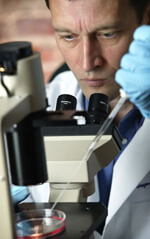Stem Cell and Brain Tumor Research

Finding successful treatments for brain tumors remains an elusive task. The Johns Hopkins Comprehensive Brain Tumor Center is currently studying the organization and cellular makeup of the stem cells in a particular portion of the human brain called the subventricular zone (SVZ). Our goal is to not only understand the function of these brain stem cells and how they may play a role in the development of brain tumors, but to ultimately genetically engineer these cells to fight brain cancer.
Neural stem cells have been suggested to function as the primary precursors of new neurons. Most of our current knowledge in this area comes from our work with rodents. Because we believe the SVZ of the brain is the most prominent region of neurgenic cells in adulthood, we have focused on understanding the rodent SVZ and comparing it to the human SVZ.
In doing so, we have been able to appreciate the intricacies of the human subventricular zone. Our studies have suggested that astrocytes (a star-shaped glial cell) in the rodent’s brains are adult neural stem cells. We now want to use human specimens to study the function of the human brain.
In our attempts to understand the human SVZ and test whether human astrocytes can function as neuronal stem cells, our laboratory is analyzing human brain tissue using special techniques to label proteins that are expressed by neuronal stem cells. We strive to learn whether the neuronal stem cells in the SVZ have oncogenic properties and if they are implicated in the development of human brain tumors. If a positive implication does exist, the hope is to develop new cell replacement approaches to treat those suffering from brain tumors.
This work is supported by grants from the NIH.
